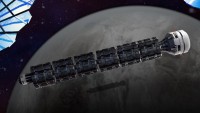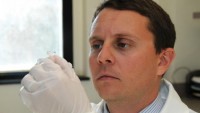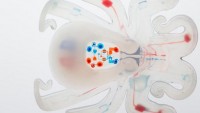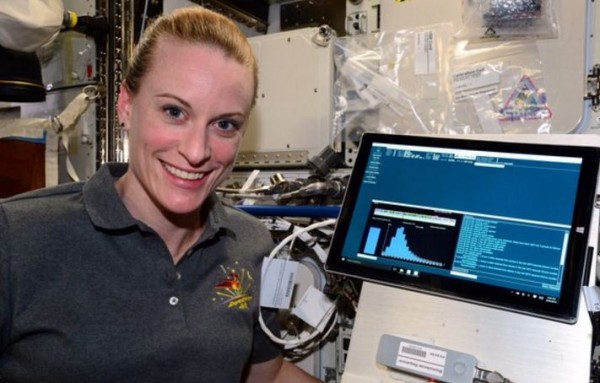DNA Sequenced in Space for the Very First Time by American Astronaut
| Arthur Dominic Villasanta | | Aug 31, 2016 10:57 AM EDT |
(Photo : NASA) NASA astronaut Dr. Kate Rubins shows the results of the first DNA sequencing in space. The MinION sequencer she used for this historic event is the small gray rectangle below the monitor.
NASA astronaut Dr. Kathleen "Kate' Rubins is the first person to sequence DNA in space and the device she used might one day help save the lives of astronauts on long space voyages.
Dr. Rubins, 37, is a microbiologist who is currently a flight engineer for Expedition 48/49 on the International Space Station (ISS). She became the 60th woman in space when she launched on Soyuz MS-01 last July.
Like Us on Facebook
Dr. Rubins received a Bachelor of Science degree in molecular biology from the University of California San Diego and a Ph.D. degree in cancer biology from Stanford University Medical School Biochemistry Department and Microbiology and Immunology Department.
NASA announced Dr. Rubins achieved this feat last week using a handheld biomolecules sequencer called MinION developed in the United Kingdom by Oxford Nanopore Technologies. The handheld sequencer allows astronauts to identify molds or bacteria aboard spacecraft and might even catalog life on other worlds.
The device can also help astronauts diagnose illness in space and allow them to identify disease-causing microbes on the ISS. DNA sequencing determines the order of the four chemical building blocks that make up the genetic information from a given living organism.
The MinION sequencer is smaller than a smartphone and uses nanopores (or very small holes) to analyze genomic data in real time. The device passes an ionic current through the nanopores, measuring changes in the current as organic molecules pass by. These changes can be used to identify each molecule.
"The test of the Biomolecule Sequencer on ISS is an important first step to learning how to sequence macromolecules like DNA in space," said Jason Dworkin, a biochemist at NASA's Goddard Space Flight Center.
"This is important to search for evidence of life elsewhere in the solar system -- Mars, Europa, Enceladus -- and be able to distinguish it from any biological contamination we brought with us from Earth."
Spores, molds, and fungi can survive in the low gravity in a spacecraft. With DNA sequencing, astronauts can identify these microbes and make informed in-flight decisions.
Before NASA's successful DNA sequencing trial, however, there was no way to sequence DNA aboard the ISS or any other crewed spacecraft. All samples had to be sent back to Earth for testing.
TagsNASA, Dr. Kathleen "Kate' Rubins, DNA, handheld biomolecules sequencer, MinION, DNA Sequencing
©2015 Chinatopix All rights reserved. Do not reproduce without permission
 Lucy, the Famous Pre-human Hominin, Plunged to her Death from a Tree
Lucy, the Famous Pre-human Hominin, Plunged to her Death from a Tree Fantastic ‘Solar Express’ will Take People to the Moon in Just Two Hours
Fantastic ‘Solar Express’ will Take People to the Moon in Just Two Hours Drug-dispensing Contact Lens Gradually Delivers Medication to Eyes of Glaucoma Patients
Drug-dispensing Contact Lens Gradually Delivers Medication to Eyes of Glaucoma Patients Harvard Researchers Create ‘Octobot,’ the First Autonomous, Entirely Soft Robot
Harvard Researchers Create ‘Octobot,’ the First Autonomous, Entirely Soft Robot
EDITOR'S PICKS
-

Did the Trump administration just announce plans for a trade war with ‘hostile’ China and Russia?
-

US Senate passes Taiwan travel bill slammed by China
-

As Yan Sihong’s family grieves, here are other Chinese students who went missing abroad. Some have never been found
-

Beijing blasts Western critics who ‘smear China’ with the term sharp power
-

China Envoy Seeks to Defuse Tensions With U.S. as a Trade War Brews
-

Singapore's Deputy PM Provides Bitcoin Vote of Confidence Amid China's Blanket Bans
-

China warns investors over risks in overseas virtual currency trading
-

Chinese government most trustworthy: survey
-

Kashima Antlers On Course For Back-To-Back Titles
MOST POPULAR
LATEST NEWS
Zhou Yongkang: China's Former Security Chief Sentenced to Life in Prison

China's former Chief of the Ministry of Public Security, Zhou Yongkang, has been given a life sentence after he was found guilty of abusing his office, bribery and deliberately ... Full Article
TRENDING STORY

China Pork Prices Expected to Stabilize As The Supplies Recover

Elephone P9000 Smartphone is now on Sale on Amazon India

There's a Big Chance Cliffhangers Won't Still Be Resolved When Grey's Anatomy Season 13 Returns

Supreme Court Ruled on Samsung vs Apple Dispute for Patent Infringement

Microsoft Surface Pro 5 Rumors and Release Date: What is the Latest?










